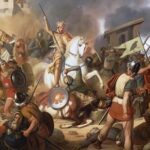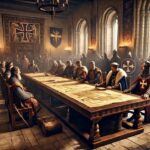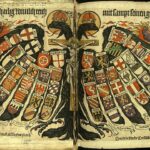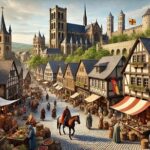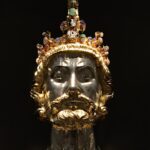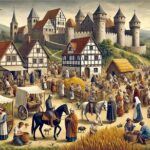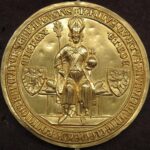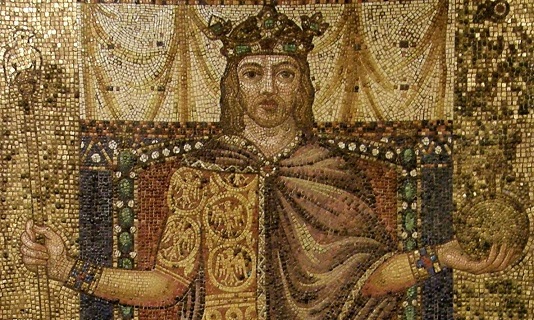
In the 10th century, as Europe emerged from the political chaos of the post-Carolingian era, one man rose to forge order from disorder—Otto the Great. Warrior, king, and emperor, Otto was the architect of a renewed empire rooted in German power and Christian faith. His reign marked the beginning of the Ottonian Dynasty, a period of consolidation, reform, and imperial ambition that helped lay the foundations of the Holy Roman Empire.
Otto didn’t just inherit a crown—he built a system. His dynasty brought together fractured duchies, tamed rebellious nobles, and set the tone for German kingship for centuries.
The German Kingdom After the Carolingians
After the Treaty of Verdun (843) split the Carolingian Empire, East Francia (modern Germany) was left fragmented. Local dukes in Saxony, Franconia, Swabia, and Bavaria held real power, while kings often had little control beyond their own lands.
By the early 900s, the Carolingians were fading. In 919, the German nobles chose a new kind of king: Henry the Fowler, Duke of Saxony. He became the first non-Carolingian ruler of East Francia. A practical man and skilled military leader, Henry laid the groundwork for a stronger monarchy—but it was his son, Otto, who would turn the vision into reality.
Otto I Becomes King
Otto I, later known as Otto the Great, became King of East Francia in 936 CE. His coronation in Aachen deliberately echoed Charlemagne’s, signaling Otto’s imperial ambitions.
From the start, Otto faced resistance:
- Powerful dukes resented his authority.
- His own family—including his brother Thankmar—challenged his rule.
- The Slavs and Magyars threatened the eastern borders.
Otto responded with a mix of force and finesse. He crushed rebellions, negotiated marriages to bring duchies under control, and placed loyal bishops in key regions. By the mid-940s, he had stabilized the kingdom.
The Battle of Lechfeld (955): Otto’s Defining Victory
One of Otto’s greatest tests came from the Magyars, nomadic raiders from the Hungarian plains who had been terrorizing Central Europe for decades. In 955, they launched a major invasion.
Otto met them at the Battle of Lechfeld, near Augsburg. His victory was decisive—and legendary. The Magyars were defeated so thoroughly that they ceased raiding Western Europe altogether. Otto’s triumph made him a hero across Christendom.
It also solidified his authority at home. German nobles, impressed by his leadership, gave him more loyalty. Otto was no longer just king—he was a protector of the realm.
The Revival of the Roman Empire
Otto’s ambitions didn’t stop at Germany. In Italy, political chaos and papal instability offered an opportunity.
In 951, Otto crossed the Alps and married Adelaide, the widowed queen of Italy, asserting his claim over Lombardy. He returned in 961 to support Pope John XII, who was facing internal threats.
In 962, Pope John crowned Otto Emperor of the Romans, reviving the imperial title in the West for the first time since Charlemagne’s coronation in 800. This moment marks the founding of the Holy Roman Empire, though the term wouldn’t be used formally for another two centuries.
Otto’s imperial coronation wasn’t just ceremonial. He soon asserted authority over the papacy itself, deposing John XII and installing a new pope. It was clear: Otto was emperor first, and the pope’s protector second.
Church and State: Otto’s Political Genius
Otto’s most innovative—and controversial—strategy was his use of the Church as an arm of the state.
Unlike secular dukes, bishops and abbots couldn’t pass on land or titles to heirs. Otto filled bishoprics with loyal supporters, creating a network of clergy who served both God and king. This policy became known as the Ottonian Church System.
The result?
- Otto had loyal administrators throughout the empire.
- Church lands became stable centers of royal power.
- A new balance emerged between sacred and secular authority.
This strategy would inspire similar models throughout medieval Europe—but also set the stage for later conflicts between emperors and popes.
The Ottonian Dynasty and Its Legacy
Otto’s successors continued his work:
- Otto II (r. 973–983): Continued imperial expansion but died young.
- Otto III (r. 983–1002): A visionary who dreamed of a revived Roman-Christian empire centered in Germany and Italy.
- Henry II (r. 1002–1024): Canonized as a saint, he solidified church reform and is considered the last Ottonian emperor.
The Ottonian period was marked by:
- Stability after the Magyar threat.
- Increased literacy and scholarship in monastic centers.
- Construction of Romanesque cathedrals and imperial abbeys.
- A blending of German kingship and Roman imperial tradition.
The Ottonians didn’t just hold power—they shaped how power was understood in the German lands.
Art and Architecture
Under the Ottonians, Ottonian art and architecture flourished:
- Lavishly illuminated manuscripts (e.g., the Gospels of Otto III).
- Romanesque-style churches, especially in Hildesheim and Quedlinburg.
- A revival of Carolingian artistic traditions, with more emphasis on imperial symbolism and Christian themes.
These artistic developments were part of the broader Ottonian Renaissance, a cultural revival that bridged the gap between the Carolingian era and the High Middle Ages.
Otto the Great was more than a warrior king. He was a unifier, reformer, and empire-builder who transformed a fragmented kingdom into a cohesive realm—and linked it to the legacy of Rome.
His reign launched the Ottonian Dynasty and helped define what it meant to be a German emperor: defender of Christendom, ally of the Church, and master of the Reich. His innovations in governance, military, and church policy set the stage for centuries of German and European history.
To continue the journey, explore The Holy Roman Empire, The Treaty of Verdun, or German Castles to see where Otto’s empire left its mark.
Related articles:
German History Timeline Overview – A concise chronological guide to major events, from early tribes to reunification and modern Germany.
The Rise of the Franks – Discover how this once-small tribe evolved into a dominant political force in early medieval Germany.
Charlemagne and the Carolingian Empire – Understand the political and cultural significance of Charlemagne’s rule across German and European lands.
The Saxons and Their Conversion to Christianity – See how religion and conquest collided as Christianity spread through northern Germanic lands.
Medieval German Feudal Society – Learn how landholding, loyalty, and class defined the social structure of medieval Germany, shaping both everyday life and royal authority.
